check engine TOYOTA C-HR 2023 Owners Manual
[x] Cancel search | Manufacturer: TOYOTA, Model Year: 2023, Model line: C-HR, Model: TOYOTA C-HR 2023Pages: 814, PDF Size: 112.62 MB
Page 7 of 814
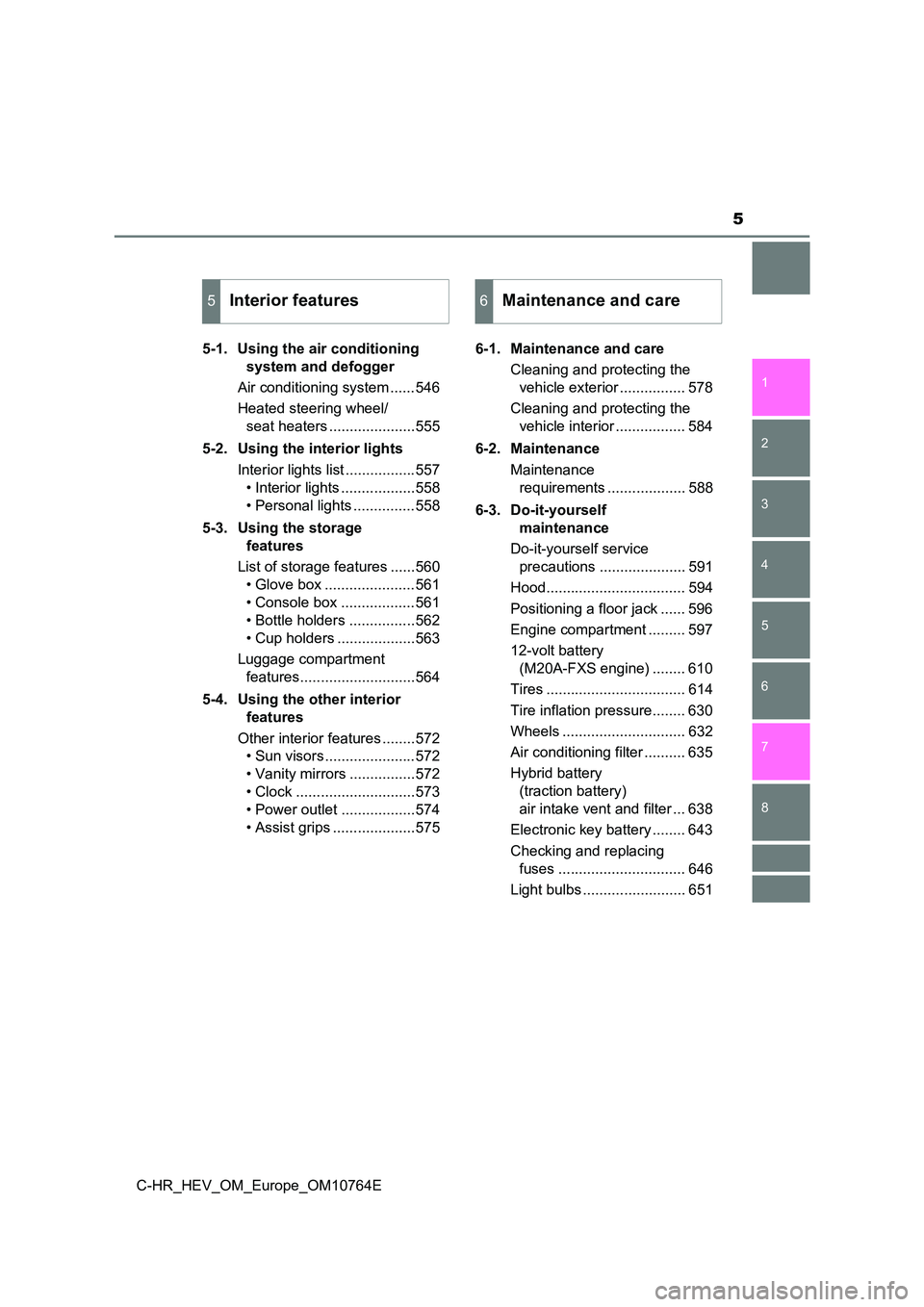
5
1
5
4
3
2
C-HR_HEV_OM_Europe_OM10764E
8
7
6
5-1. Using the air conditioning
system and defogger
Air conditioning system ......546
Heated steering wheel/
seat heaters .....................555
5-2. Using the interior lights
Interior lights list .................557
• Interior lights ..................558
• Personal lights ...............558
5-3. Using the storage
features
List of storage features ......560
• Glove box ......................561
• Console box ..................561
• Bottle holders ................562
• Cup holders ...................563
Luggage compartment
features............................564
5-4. Using the other interior
features
Other interior features ........572
• Sun visors ......................572
• Vanity mirrors ................572
• Clock .............................573
• Power outlet ..................574
• Assist grips ....................575
6-1. Maintenance and care
Cleaning and protecting the
vehicle exterior ................ 578
Cleaning and protecting the
vehicle interior ................. 584
6-2. Maintenance
Maintenance
requirements ................... 588
6-3. Do-it-yourself
maintenance
Do-it-yourself service
precautions ..................... 591
Hood.................................. 594
Positioning a floor jack ...... 596
Engine compartment ......... 597
12-volt battery
(M20A-FXS engine) ........ 610
Tires .................................. 614
Tire inflation pressure........ 630
Wheels .............................. 632
Air conditioning filter .......... 635
Hybrid battery
(traction battery)
air intake vent and filter ... 638
Electronic key battery ........ 643
Checking and replacing
fuses ............................... 646
Light bulbs ......................... 651
5Interior features6Maintenance and care
Page 17 of 814
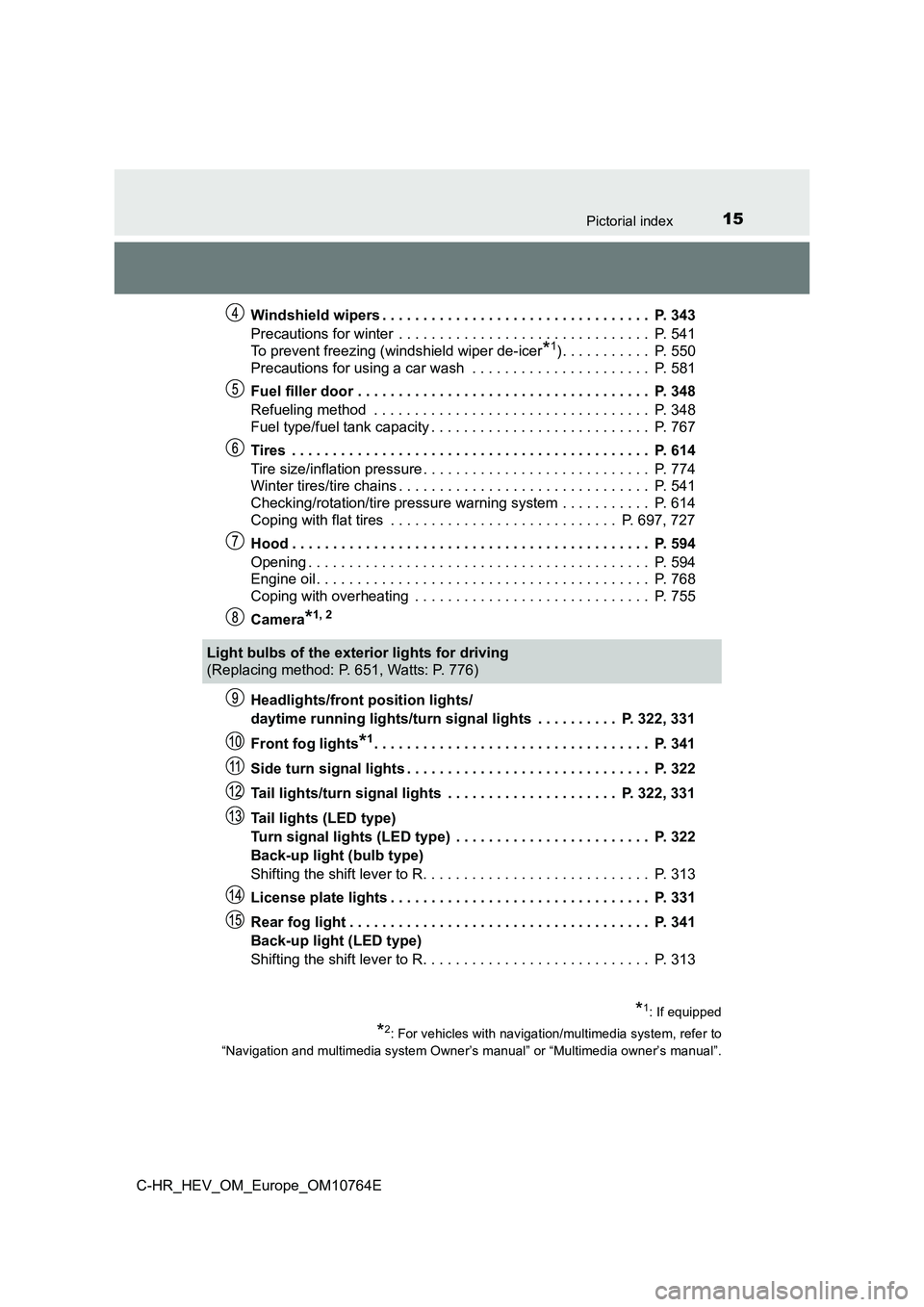
15Pictorial index
C-HR_HEV_OM_Europe_OM10764E
Windshield wipers . . . . . . . . . . . . . . . . . . . . . . . . . . . . . . . . . P. 343
Precautions for winter . . . . . . . . . . . . . . . . . . . . . . . . . . . . . . . P. 541
To prevent freezing (windshield wiper de-icer*1) . . . . . . . . . . . P. 550
Precautions for using a car wash . . . . . . . . . . . . . . . . . . . . . . P. 581
Fuel filler door . . . . . . . . . . . . . . . . . . . . . . . . . . . . . . . . . . . . P. 348
Refueling method . . . . . . . . . . . . . . . . . . . . . . . . . . . . . . . . . . P. 348
Fuel type/fuel tank capacity . . . . . . . . . . . . . . . . . . . . . . . . . . . P. 767
Tires . . . . . . . . . . . . . . . . . . . . . . . . . . . . . . . . . . . . . . . . . . . . P. 614
Tire size/inflation pressure . . . . . . . . . . . . . . . . . . . . . . . . . . . . P. 774
Winter tires/tire chains . . . . . . . . . . . . . . . . . . . . . . . . . . . . . . . P. 541
Checking/rotation/tire pressure warning system . . . . . . . . . . . P. 614
Coping with flat tires . . . . . . . . . . . . . . . . . . . . . . . . . . . . P. 697, 727
Hood . . . . . . . . . . . . . . . . . . . . . . . . . . . . . . . . . . . . . . . . . . . . P. 594
Opening . . . . . . . . . . . . . . . . . . . . . . . . . . . . . . . . . . . . . . . . . . P. 594
Engine oil . . . . . . . . . . . . . . . . . . . . . . . . . . . . . . . . . . . . . . . . . P. 768
Coping with overheating . . . . . . . . . . . . . . . . . . . . . . . . . . . . . P. 755
Camera*1, 2
Headlights/front position lights/
daytime running lights/turn sig nal lights . . . . . . . . . . P. 322, 331
Front fog lights*1. . . . . . . . . . . . . . . . . . . . . . . . . . . . . . . . . . P. 341
Side turn signal lights . . . . . . . . . . . . . . . . . . . . . . . . . . . . . . P. 322
Tail lights/turn signal lights . . . . . . . . . . . . . . . . . . . . . P. 322, 331
Tail lights (LED type)
Turn signal lights (LED type) . . . . . . . . . . . . . . . . . . . . . . . . P. 322
Back-up light (bulb type)
Shifting the shift lever to R. . . . . . . . . . . . . . . . . . . . . . . . . . . . P. 313
License plate lights . . . . . . . . . . . . . . . . . . . . . . . . . . . . . . . . P. 331
Rear fog light . . . . . . . . . . . . . . . . . . . . . . . . . . . . . . . . . . . . . P. 341
Back-up light (LED type)
Shifting the shift lever to R. . . . . . . . . . . . . . . . . . . . . . . . . . . . P. 313
Light bulbs of the exterior lights for driving
(Replacing method: P. 651, Watts: P. 776)
*1: If equipped
*2: For vehicles with navigation/multimedia system, refer to
“Navigation and multimedia system Owner’s manual” or “Multimedi a owner’s manual”.
Page 169 of 814
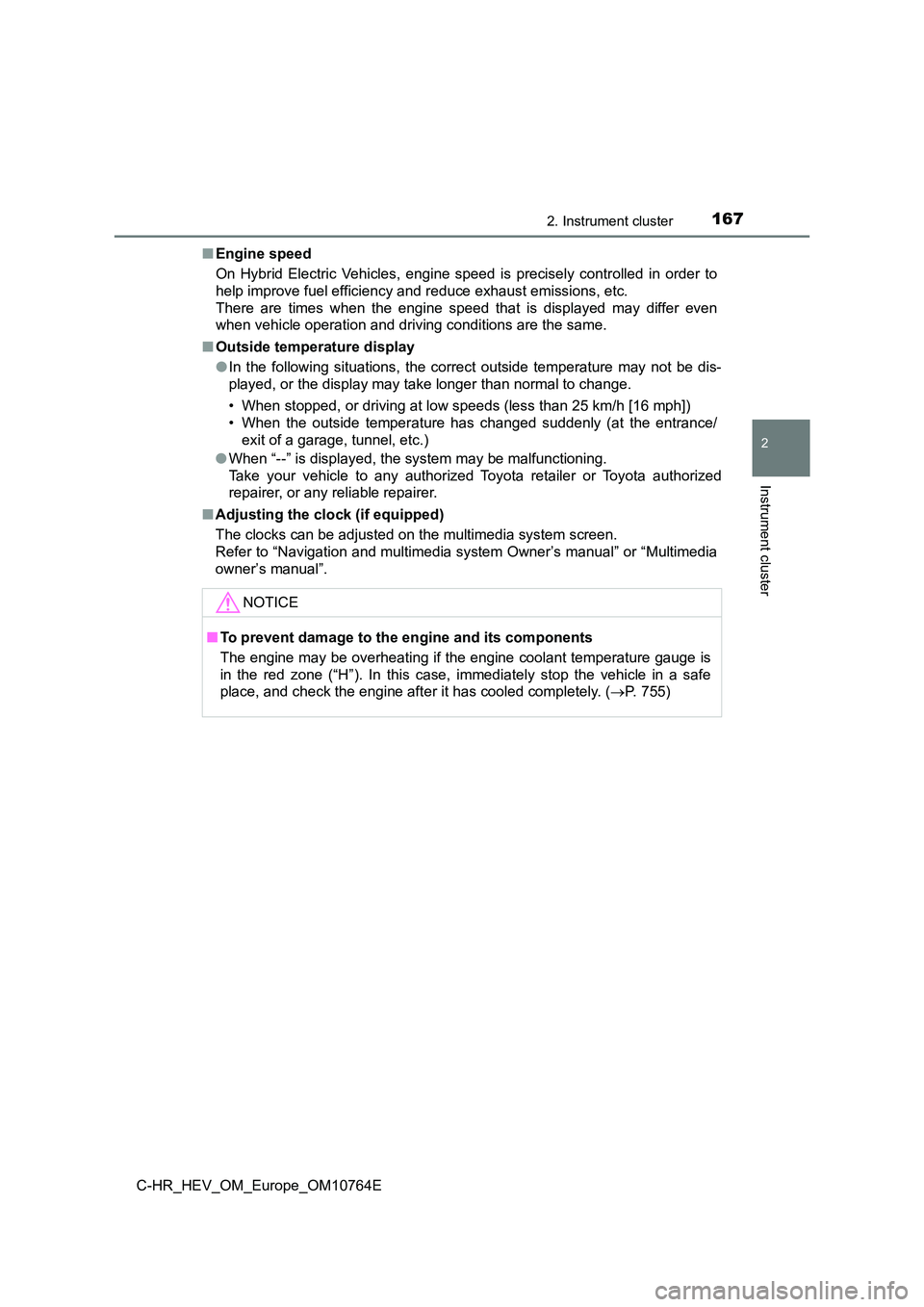
1672. Instrument cluster
2
Instrument cluster
C-HR_HEV_OM_Europe_OM10764E
■ Engine speed
On Hybrid Electric Vehicles, engine speed is precisely controll ed in order to
help improve fuel efficiency and reduce exhaust emissions, etc.
There are times when the engine speed that is displayed may dif fer even
when vehicle operation and driving conditions are the same.
■ Outside temperature display
● In the following situations, the correct outside temperature may not be dis-
played, or the display may take longer than normal to change.
• When stopped, or driving at low speeds (less than 25 km/h [16 mph])
• When the outside temperature has changed suddenly (at the entr ance/
exit of a garage, tunnel, etc.)
● When “--” is displayed, the system may be malfunctioning.
Take your vehicle to any authorized Toyota retailer or Toyota a uthorized
repairer, or any reliable repairer.
■ Adjusting the clock (if equipped)
The clocks can be adjusted on the multimedia system screen.
Refer to “Navigation and multimedia system Owner’s manual” or “ Multimedia
owner’s manual”.
NOTICE
■ To prevent damage to the engine and its components
The engine may be overheating if the engine coolant temperature gauge is
in the red zone (“H”). In this case, immediately stop the vehic le in a safe
place, and check the engine after it has cooled completely. ( P. 755)
Page 288 of 814
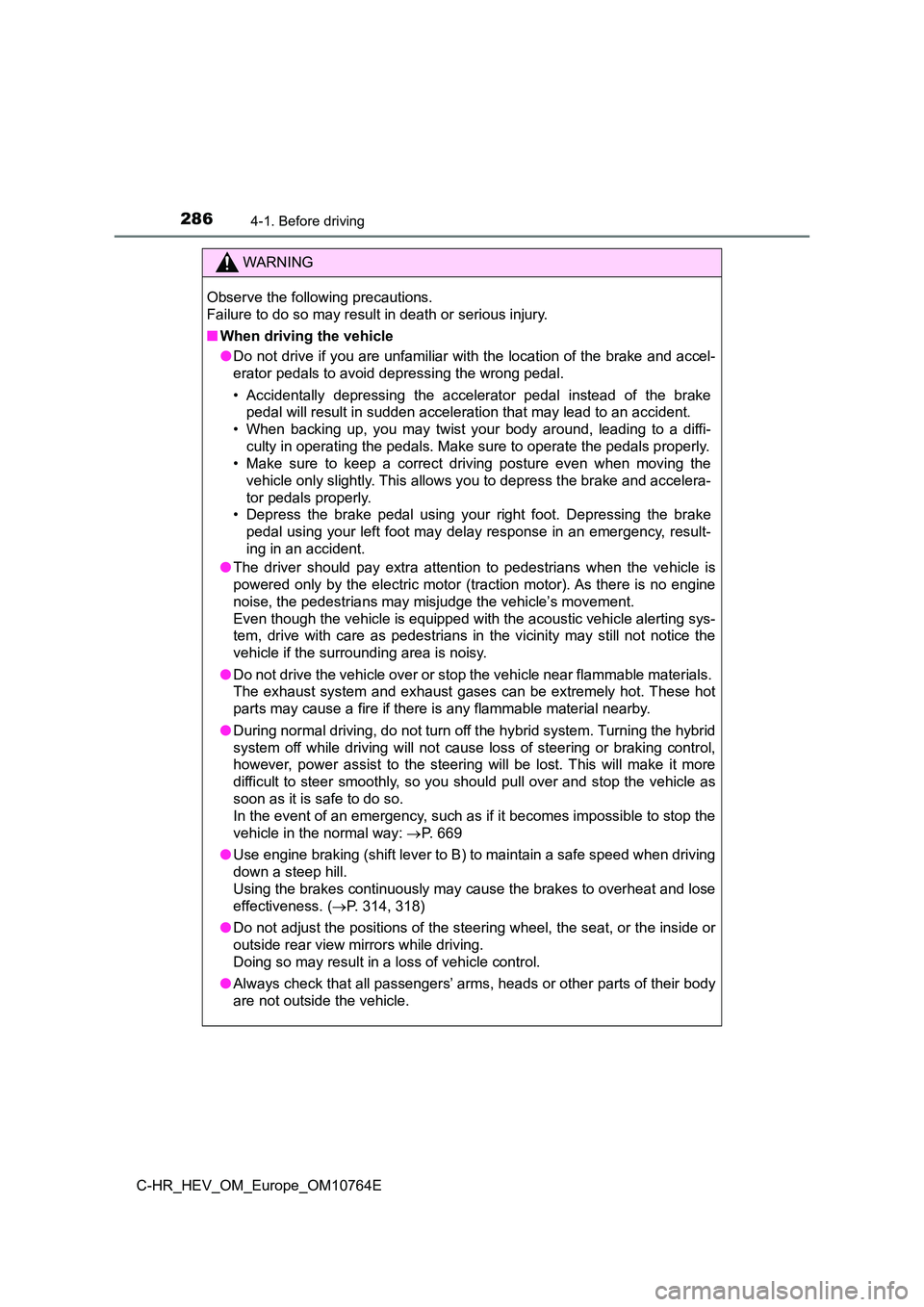
2864-1. Before driving
C-HR_HEV_OM_Europe_OM10764E
WARNING
Observe the following precautions.
Failure to do so may result in death or serious injury.
■ When driving the vehicle
● Do not drive if you are unfamiliar with the location of the brake and accel-
erator pedals to avoid depressing the wrong pedal.
• Accidentally depressing the accelerator pedal instead of the b rake
pedal will result in sudden acceleration that may lead to an ac cident.
• When backing up, you may twist your body around, leading to a diffi-
culty in operating the pedals. Make sure to operate the pedals properly.
• Make sure to keep a correct driving posture even when moving t he
vehicle only slightly. This allows you to depress the brake and accelera-
tor pedals properly.
• Depress the brake pedal using your right foot. Depressing the brake
pedal using your left foot may delay response in an emergency, result-
ing in an accident.
● The driver should pay extra attention to pedestrians when the vehicle is
powered only by the electric motor (traction motor). As there i s no engine
noise, the pedestrians may misjudge the vehicle’s movement.
Even though the vehicle is equipped with the acoustic vehicle a lerting sys-
tem, drive with care as pedestrians in the vicinity may still n ot notice the
vehicle if the surrounding area is noisy.
● Do not drive the vehicle over or stop the vehicle near flammable materials.
The exhaust system and exhaust gases can be extremely hot. Thes e hot
parts may cause a fire if there is any flammable material nearb y.
● During normal driving, do not turn off the hybrid system. Turning the hybrid
system off while driving will not cause loss of steering or bra king control,
however, power assist to the steering will be lost. This will m ake it more
difficult to steer smoothly, so you should pull over and stop t he vehicle as
soon as it is safe to do so.
In the event of an emergency, such as if it becomes impossible to stop the
vehicle in the normal way: P. 669
● Use engine braking (shift lever to B) to maintain a safe speed when driving
down a steep hill.
Using the brakes continuously may cause the brakes to overheat and lose
effectiveness. ( P. 314, 318)
● Do not adjust the positions of the steering wheel, the seat, or the inside or
outside rear view mirrors while driving.
Doing so may result in a loss of vehicle control.
● Always check that all passengers’ arms, heads or other parts of their body
are not outside the vehicle.
Page 290 of 814
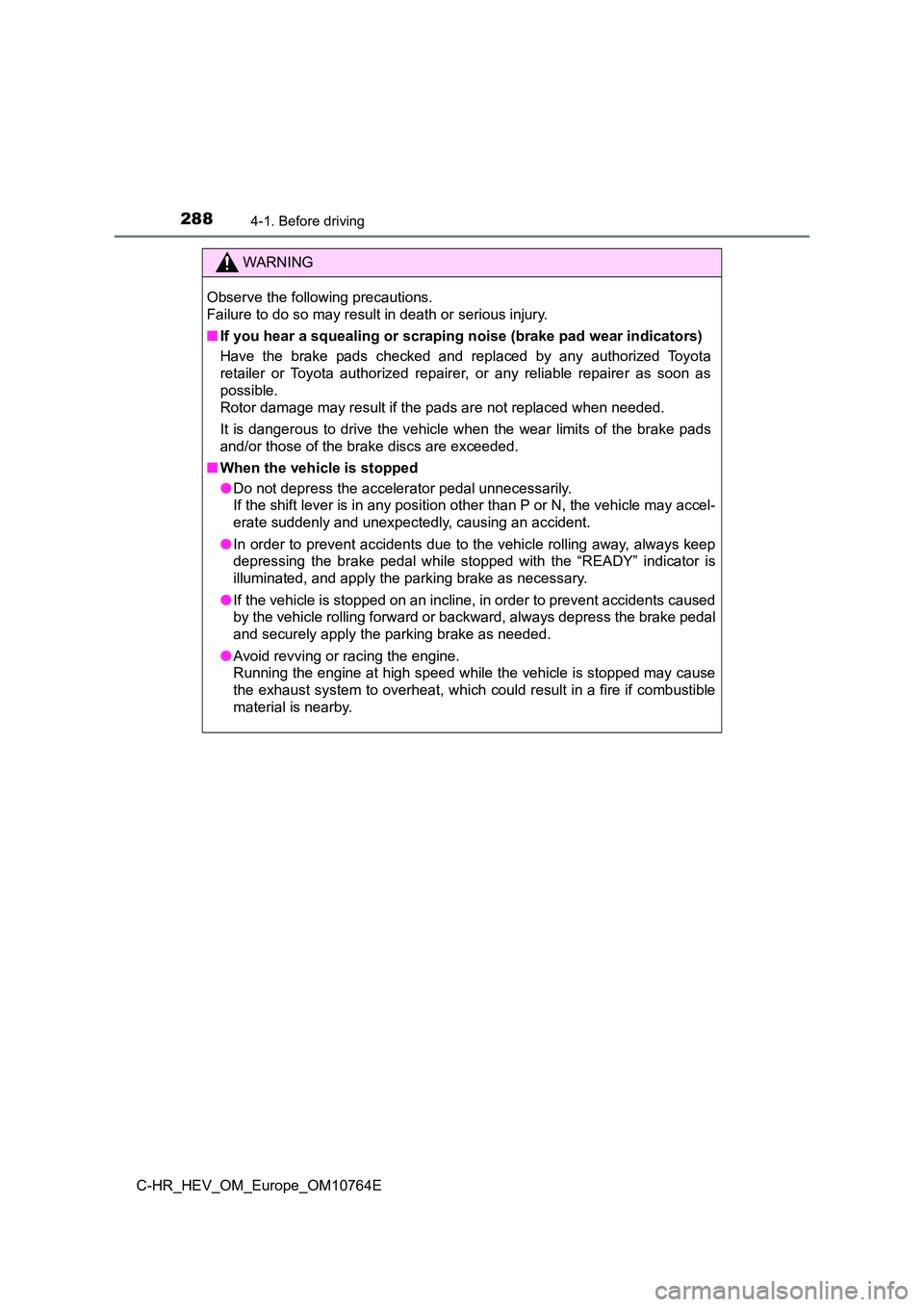
2884-1. Before driving
C-HR_HEV_OM_Europe_OM10764E
WARNING
Observe the following precautions.
Failure to do so may result in death or serious injury.
■ If you hear a squealing or scraping noise (brake pad wear indicators)
Have the brake pads checked and replaced by any authorized Toyo ta
retailer or Toyota authorized repairer, or any reliable repaire r as soon as
possible.
Rotor damage may result if the pads are not replaced when neede d.
It is dangerous to drive the vehicle when the wear limits of th e brake pads
and/or those of the brake discs are exceeded.
■ When the vehicle is stopped
● Do not depress the accelerator pedal unnecessarily.
If the shift lever is in any position other than P or N, the ve hicle may accel-
erate suddenly and unexpectedly, causing an accident.
● In order to prevent accidents due to the vehicle rolling away, always keep
depressing the brake pedal while stopped with the “READY” indic ator is
illuminated, and apply the parking brake as necessary.
● If the vehicle is stopped on an incline, in order to prevent accidents caused
by the vehicle rolling forward or backward, always depress the brake pedal
and securely apply the parking brake as needed.
● Avoid revving or racing the engine.
Running the engine at high speed while the vehicle is stopped m ay cause
the exhaust system to overheat, which could result in a fire if combustible
material is nearby.
Page 294 of 814
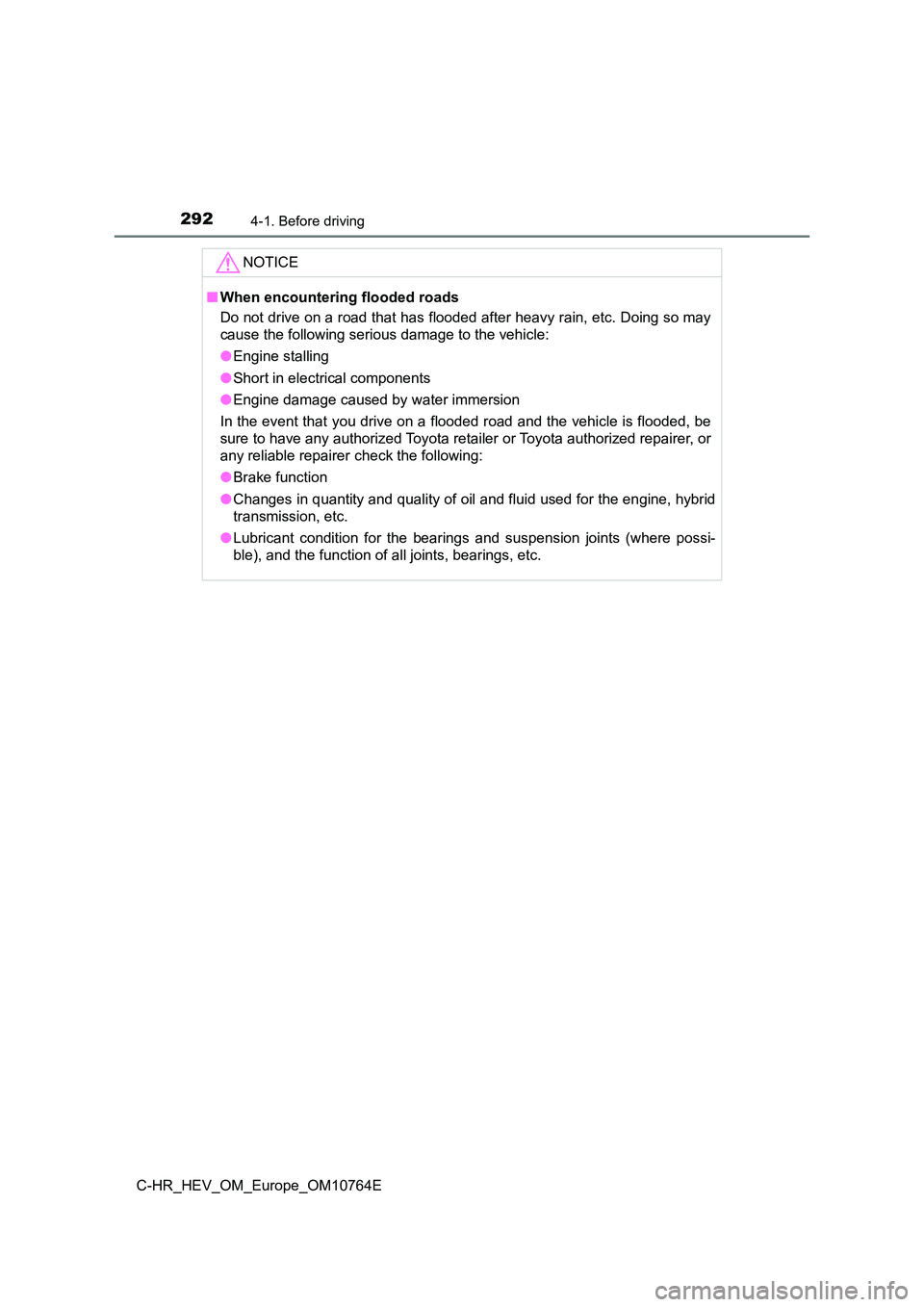
2924-1. Before driving
C-HR_HEV_OM_Europe_OM10764E
NOTICE
■When encountering flooded roads
Do not drive on a road that has flooded after heavy rain, etc. Doing so may
cause the following serious damage to the vehicle:
● Engine stalling
● Short in electrical components
● Engine damage caused by water immersion
In the event that you drive on a flooded road and the vehicle i s flooded, be
sure to have any authorized Toyota retailer or Toyota authorize d repairer, or
any reliable repairer check the following:
● Brake function
● Changes in quantity and quality of oil and fluid used for the engine, hybrid
transmission, etc.
● Lubricant condition for the bearings and suspension joints (where possi-
ble), and the function of all joints, bearings, etc.
Page 303 of 814
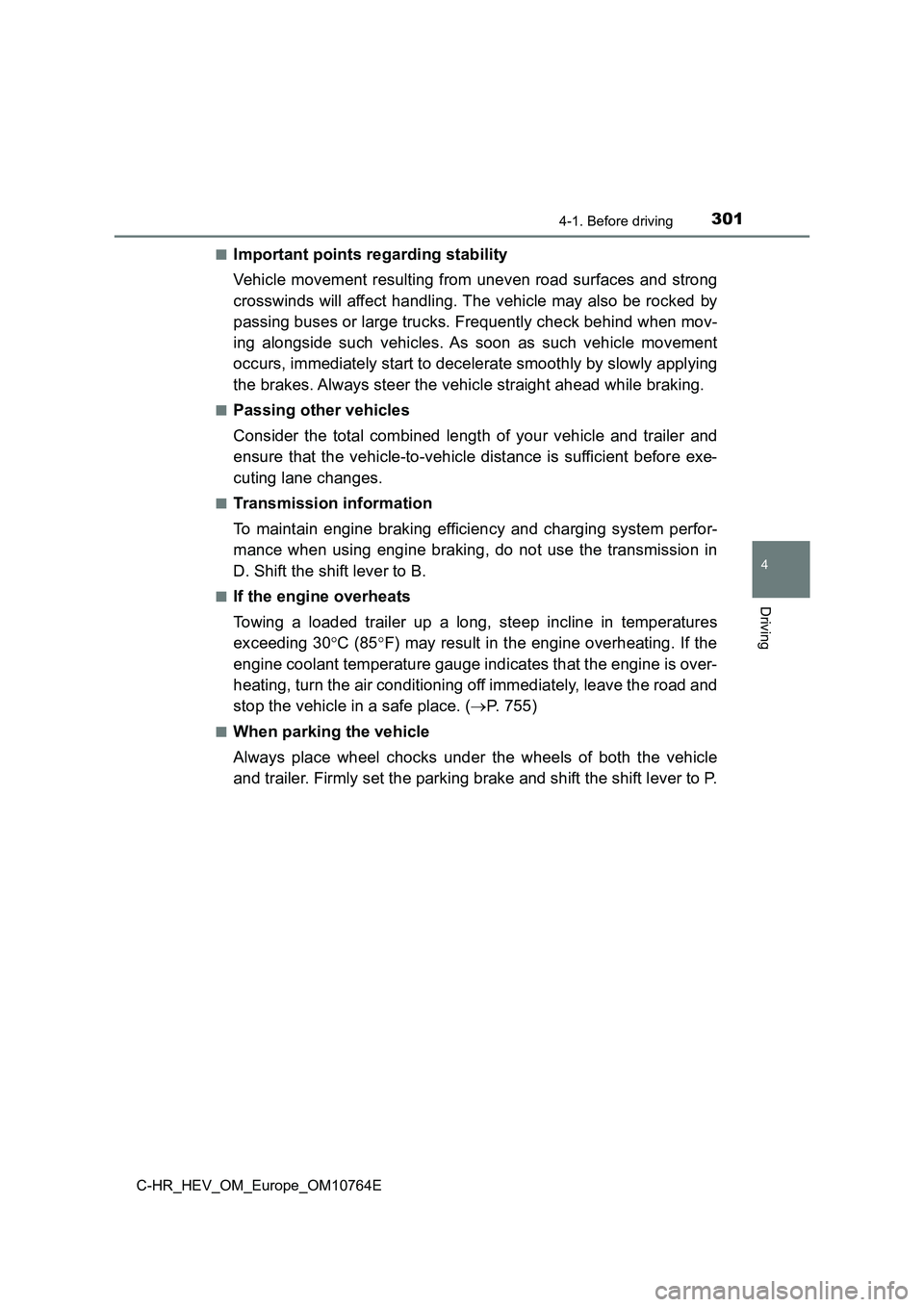
3014-1. Before driving
4
Driving
C-HR_HEV_OM_Europe_OM10764E
■Important points regarding stability
Vehicle movement resulting from uneven road surfaces and strong
crosswinds will affect handling. The vehicle may also be rocked by
passing buses or large trucks. Frequently check behind when mov -
ing alongside such vehicles. As soon as such vehicle movement
occurs, immediately start to decelerate smoothly by slowly appl ying
the brakes. Always steer the vehicle straight ahead while braki ng.
■Passing other vehicles
Consider the total combined length of your vehicle and trailer and
ensure that the vehicle-to-vehicle distance is sufficient befor e exe-
cuting lane changes.
■Transmission information
To maintain engine braking efficiency and charging system perfo r-
mance when using engine braking, do not use the transmission in
D. Shift the shift lever to B.
■If the engine overheats
Towing a loaded trailer up a long, steep incline in temperature s
exceeding 30 C (85F) may result in the engine overheating. If the
engine coolant temperature gauge indicates that the engine is o ver-
heating, turn the air conditioning off immediately, leave the r oad and
stop the vehicle in a safe place. ( P. 755)
■When parking the vehicle
Always place wheel chocks under the wheels of both the vehicle
and trailer. Firmly set the parking brake and shift the shift l ever to P.
Page 305 of 814
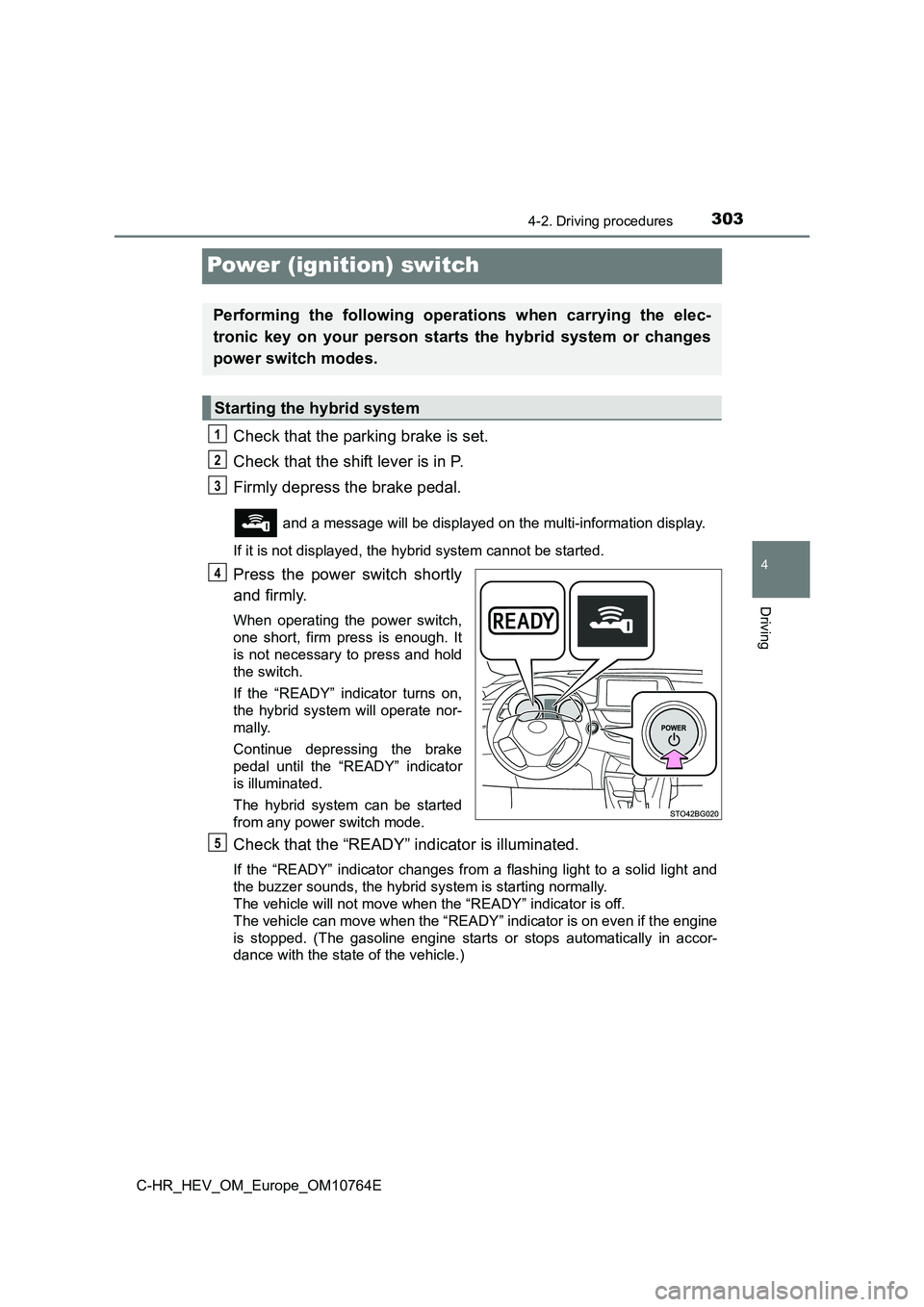
303
4
4-2. Driving procedures
Driving
C-HR_HEV_OM_Europe_OM10764E
Power (ignition) switch
Check that the parking brake is set.
Check that the shift lever is in P.
Firmly depress the brake pedal.
and a message will be displayed on the multi-information displ ay.
If it is not displayed, the hybrid system cannot be started.
Press the power switch shortly
and firmly.
When operating the power switch,
one short, firm press is enough. It
is not necessary to press and hold
the switch.
If the “READY” indicator turns on,
the hybrid system will operate nor-
mally.
Continue depressing the brake
pedal until the “READY” indicator
is illuminated.
The hybrid system can be started
from any power switch mode.
Check that the “READY” indicator is illuminated.
If the “READY” indicator changes from a flashing light to a sol id light and
the buzzer sounds, the hybrid system is starting normally.
The vehicle will not move when the “READY” indicator is off.
The vehicle can move when the “READY” indicator is on even if t he engine
is stopped. (The gasoline engine starts or stops automatically in accor-
dance with the state of the vehicle.)
Performing the following operations when carrying the elec-
tronic key on your person starts the hybrid system or changes
power switch modes.
Starting the hybrid system
1
2
3
4
5
Page 317 of 814
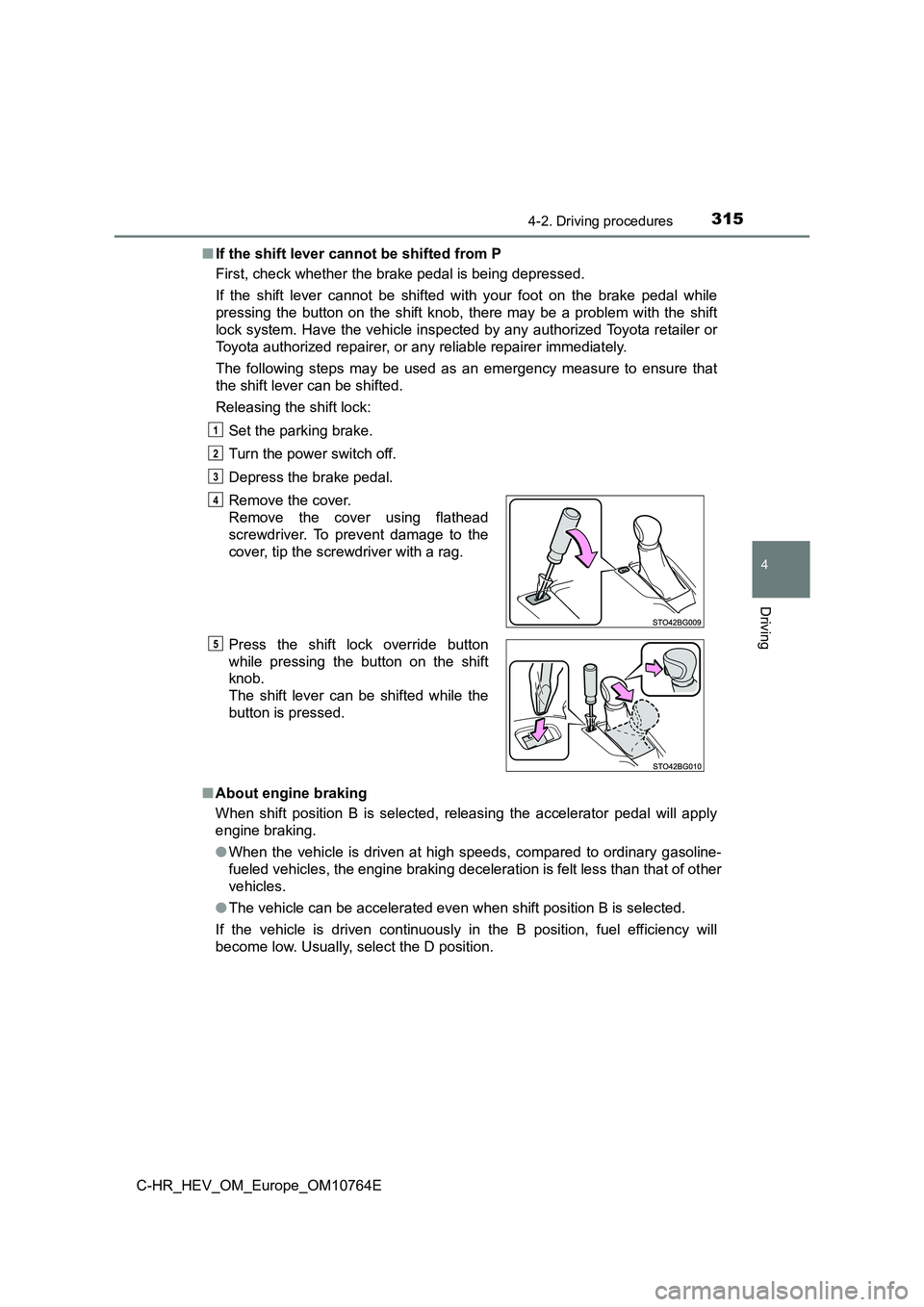
3154-2. Driving procedures
4
Driving
C-HR_HEV_OM_Europe_OM10764E
■ If the shift lever cannot be shifted from P
First, check whether the brake pedal is being depressed.
If the shift lever cannot be shifted with your foot on the brak e pedal while
pressing the button on the shift knob, there may be a problem w ith the shift
lock system. Have the vehicle inspected by any authorized Toyot a retailer or
Toyota authorized repairer, or any reliable repairer immediatel y.
The following steps may be used as an emergency measure to ensu re that
the shift lever can be shifted.
Releasing the shift lock:
Set the parking brake.
Turn the power switch off.
Depress the brake pedal.
■ About engine braking
When shift position B is selected, releasing the accelerator pe dal will apply
engine braking.
● When the vehicle is driven at high speeds, compared to ordinary gasoline-
fueled vehicles, the engine braki ng deceleration is felt less than that of other
vehicles.
● The vehicle can be accelerated even when shift position B is selected.
If the vehicle is driven continuously in the B position, fuel e fficiency will
become low. Usually, select the D position.
Remove the cover.
Remove the cover using flathead
screwdriver. To prevent damage to the
cover, tip the screwdriver with a rag.
Press the shift lock override button
while pressing the button on the shift
knob.
The shift lever can be shifted while the
button is pressed.
1
2
3
4
5
Page 321 of 814
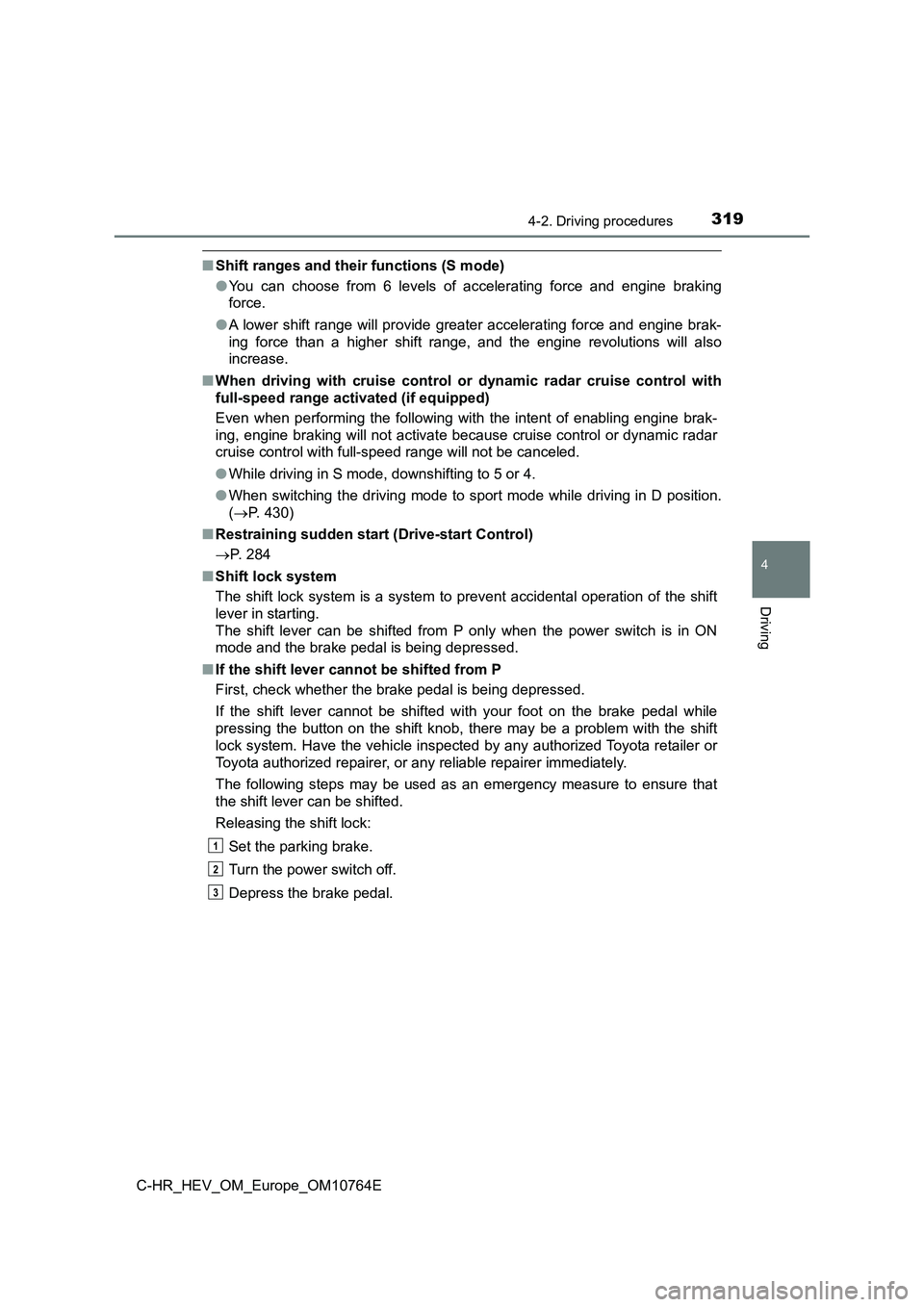
3194-2. Driving procedures
4
Driving
C-HR_HEV_OM_Europe_OM10764E
■Shift ranges and their functions (S mode)
● You can choose from 6 levels of accelerating force and engine braking
force.
● A lower shift range will provide greater accelerating force and engine brak-
ing force than a higher shift range, and the engine revolutions will also
increase.
■ When driving with cruise control or dynamic radar cruise control with
full-speed range acti vated (if equipped)
Even when performing the following with the intent of enabling engine brak-
ing, engine braking will not activate because cruise control or dynamic radar
cruise control with full-speed range will not be canceled.
● While driving in S mode, downshifting to 5 or 4.
● When switching the driving mode to sport mode while driving in D position.
( P. 430)
■ Restraining sudden start (Drive-start Control)
P. 284
■ Shift lock system
The shift lock system is a system to prevent accidental operati on of the shift
lever in starting.
The shift lever can be shifted from P only when the power switc h is in ON
mode and the brake pedal is being depressed.
■ If the shift lever cannot be shifted from P
First, check whether the brake pedal is being depressed.
If the shift lever cannot be shifted with your foot on the brak e pedal while
pressing the button on the shift knob, there may be a problem w ith the shift
lock system. Have the vehicle inspected by any authorized Toyot a retailer or
Toyota authorized repairer, or any reliable repairer immediatel y.
The following steps may be used as an emergency measure to ensu re that
the shift lever can be shifted.
Releasing the shift lock:
Set the parking brake.
Turn the power switch off.
Depress the brake pedal.
1
2
3